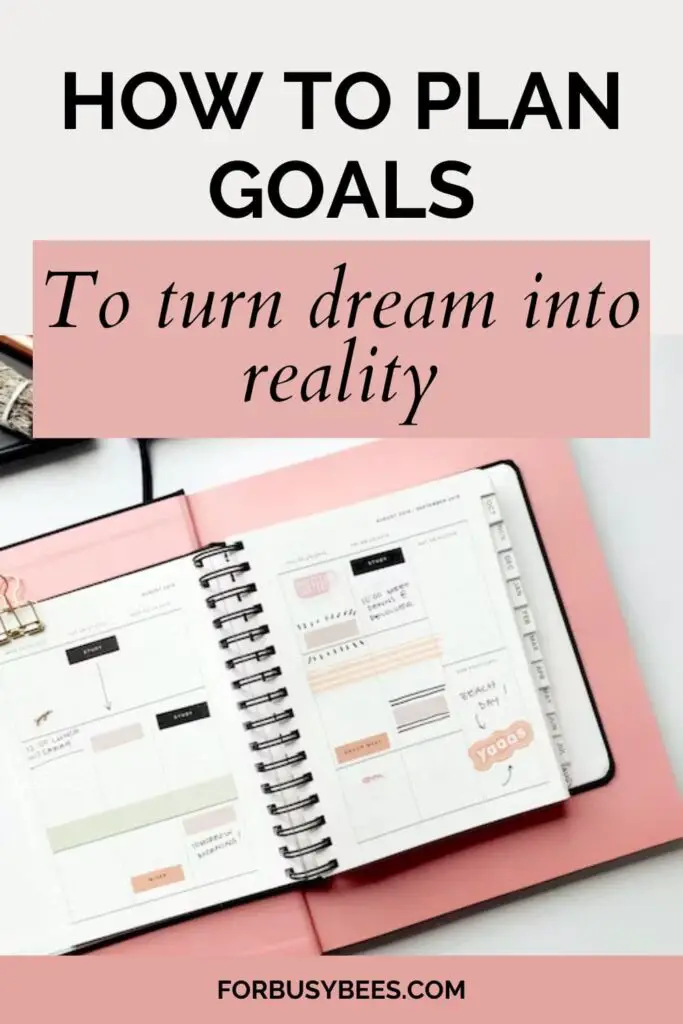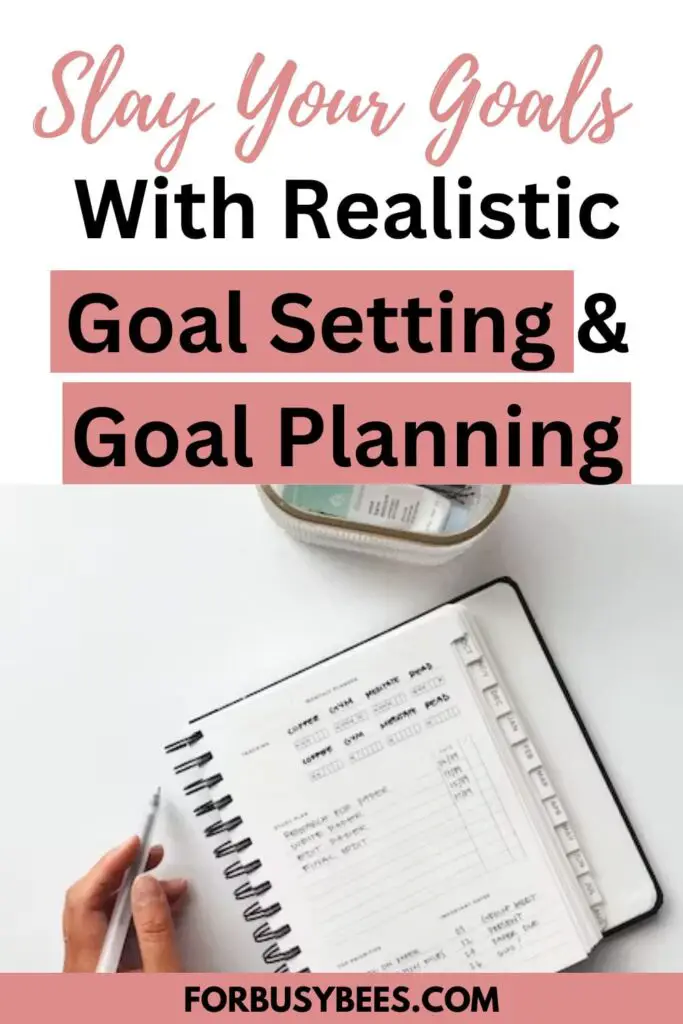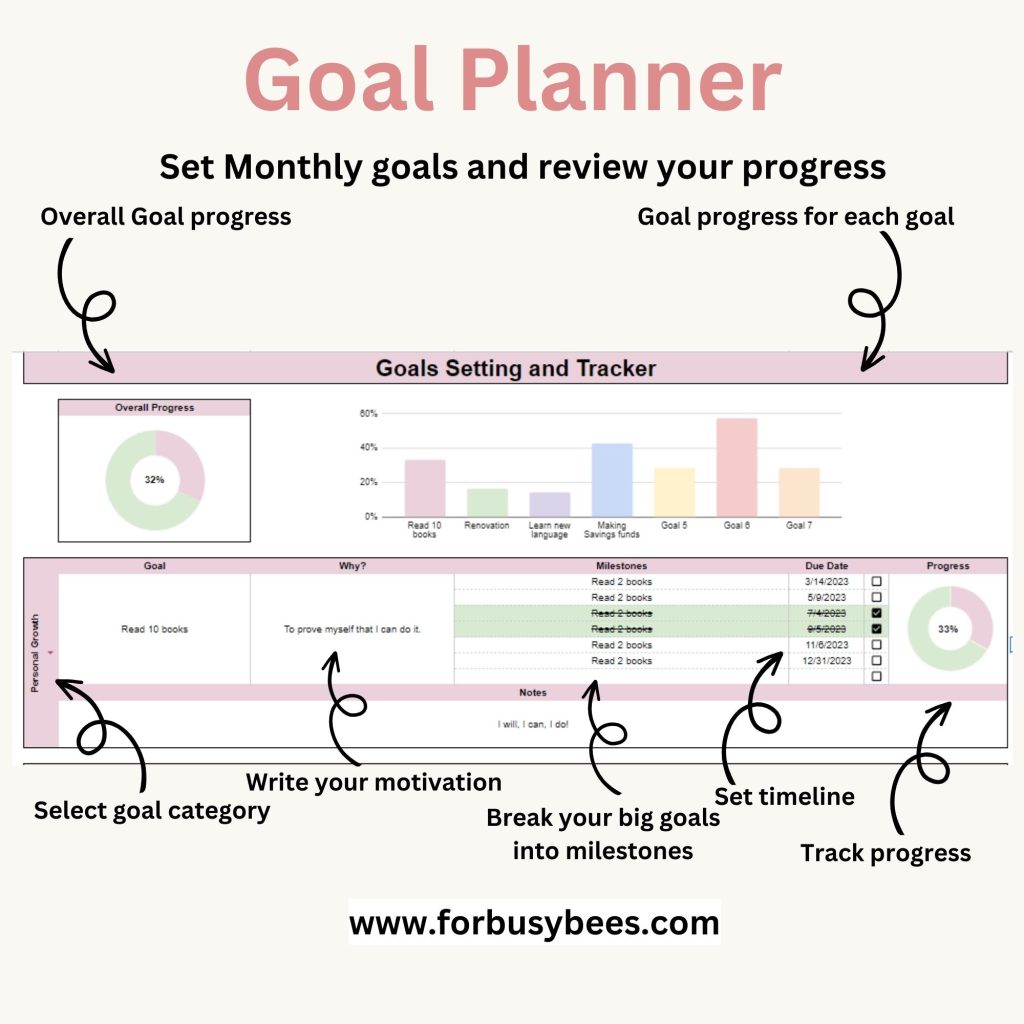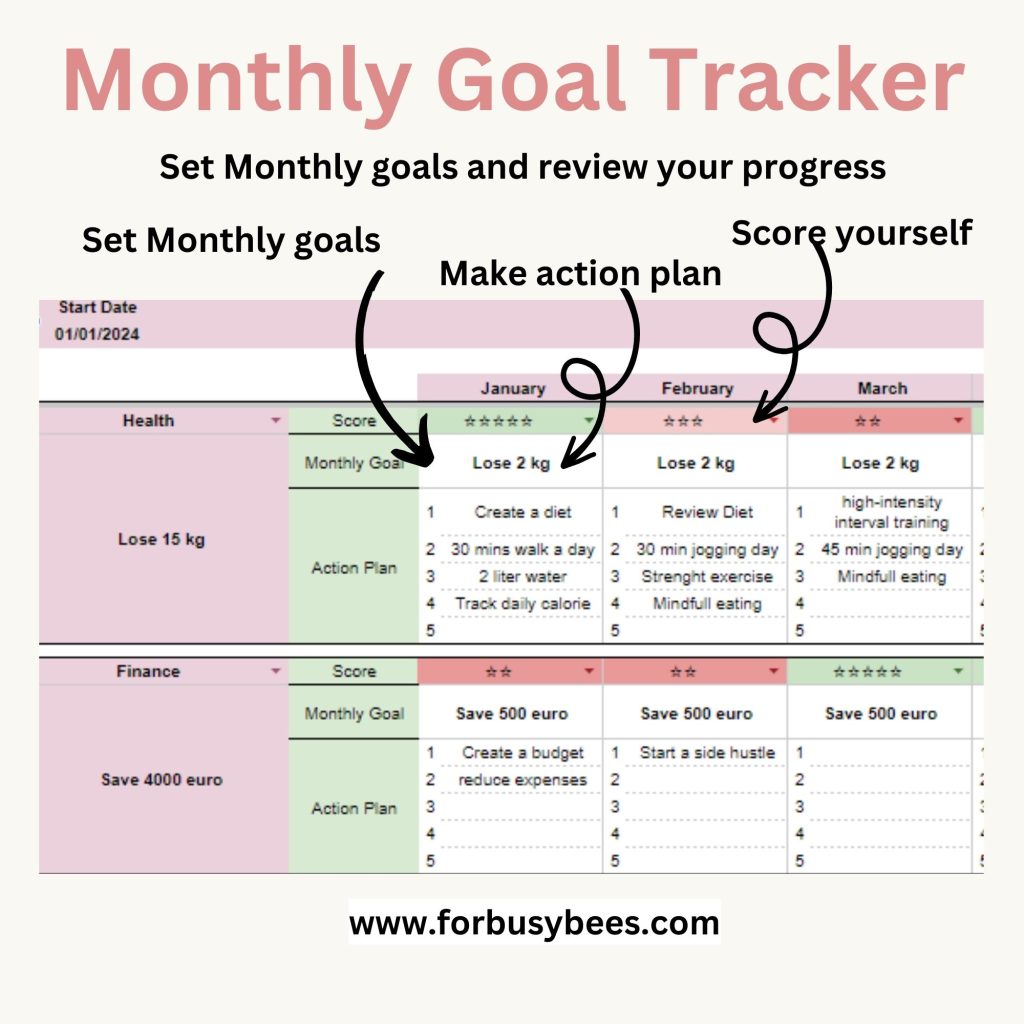Goal Settings and Goal Planning 101 to make your dream reality

Do you find goal setting and goal planning daunting? You make resolutions for the new year and never meet them, that’s common for many but there is a way to make it simpler than you think. In this post, I am sharing a very simplified way to set your goal and plan smart goals that are realistic. You can use the concept for new year goal planning or, 6 months, 1 year, or 5 years goal planning. Also, make sure to get your free goal-planning and goal-setting printable worksheets.
Why Set Goals?
Setting goals gives you a clear vision and a road map to your achievements. Starting a new year without setting goals is like starting a journey without any idea of a destination or direction.
According to an article in The American psychological association setting goals provide three main benefits
- Enlighten you: It gives you an insight into your needs and requirements, helps you identify your strength and area of improvement, makes you look ahead of time to think and visualize where you want to be, gives you clarity on yourself, and idealizes what you want to be.
- Encourage you: Goal setting motivates you to work towards your goal, increases your efficiency, and encourages you to build skills and implement a plan to ensure goals are achieved.
- Enable you: Goal setting enables you to take the right action required to achieve goals, take strategic decisions and plan your work and evaluate yourself to keep up with the progress of meeting your goals.
According to a famous study conducted at Harvard on setting goals, 10 years later to setting goals when people were interviewed, it was found that 13% who had goals but had not planned goals were earning twice that of 84% who had no specific goals at all, but 3% who had had clear, written goals and plans to accomplish were earning 10 times than the others.
Also, according to a study at Dominican University, California, it was found that people with written goals achieved them better compared to unwritten goals. Also, those who shared performance with an accountability partner achieved much better.
Clearly, it is best to not just set goals and also plan goals. Now that you are convinced on setting goals and planning goals let’s dive deep into it.
How to Set Clear Goals
Here is a step-by-step process to help you set clear goals that will give you clarity and bring more value to your life.

Step 1: Review the past
Before starting with goal setting, always review your past it can be the previous year or past few months covering all the aspects of your life. This is often ignored and you may get excited to set new goals but this is crucial to help you understand where you stand at the moment and align your vision with your reality. This will help you identify areas you need to work on in order to improve your life.
To do this just identify key areas of your life and reflect on your life. To make it easier can refer to my post 100 reflection questions for self-review, these questions will serve as a prompt to help you review your previous year for the most common areas of your life and get you realistic picture of your life.
P.S. You may like to do a life audit if you are completely lost and want to transform your life, if so you must read How to do a life audit.
Step 2: Identify your goals
After reviewing the past few months or year it is now time to identify your goals. When identifying your goals you must consider things that you want to achieve in life, the lifestyle that you want to have, and learnings from self-reflection to improve yourself.
When setting goals identify significant areas of your life to have comprehensive goals for your life that will make your life better and will not be just limited to one aspect of your life. Setting goals that will give you a balanced life will take you a long way. Depending on the stage of your life, you may have one having more priority than the other. But still, you should have some goals for all major areas of your life to have balanced growth in life.
I like to cover these 6 areas of life while setting my goals:
Health or Fitness Goals
This includes your health conditions like weight, cholesterol, fitness and energy, your diet, and your exercise regime.
Professional and Career Goals
This includes your aspiration at work, be it the job position that you want to achieve or the growth you want your business to achieve, or maybe a side hustle that you want to pursue.
Financial Goals
This includes the saving that you want to make for your desires and the control that you want to excise on your current expense or an investment you need to make to grow money.
Intellectual Goals
This includes your self-growth, it can be nurturing your mind with good books or learning new skills for work or a hobby for yourself
Emotional Goals
This includes working for your emotions such as dealing with bad emotions like anxiety or self-doubt. It can also be working towards good emotions like feeling gratitude, and peace.
Relationship or social Goals
This includes working towards building or maintaining good relations with your partner, kids, parents, friend, and colleagues.
Setting at least one goal in each area will make your goal-setting comprehensive. You can use my free goal planning printable, it will guide you to identify your goal.
If you are unable to decide your new goal, I highly recommend you review your current state in all the areas above and this will lead you to your goals.
Step 3: Define goals
Just identifying your goals will not be sufficient to get your goals into action. You need more clarity by defining them.
The most common and efficient way to define a goal is by the technique “SMART”, which suggests defining your goal as below.
Specific: You should specifically define your goal. Eg. “I want to be healthy” is not specific but “I want to lose weight” is the specific goal
Measurable: You should define your goal with a measurement to assess your progress and know the efforts required to achieve it. Eg. “I want to lose weight is the specific goal” is measurable if it is “I want to lose weight 10 pounds”
Achievable: Your goals should be achievable and realistic, although you should be moving out of your comfort zone when you set a new goal to get better at the same time the goal should be attainable in the time planned and other resources required. Eg. If you set a goal to lose 10 pounds in 30 days. It’s not a possible healthy way to do so.
Relevant: Your goal should be relevant to the vision you have and should align with the purpose you intend to achieve. Having a goal that does not line up with your big picture will not give you the success you wish and there is a possibility that you may just leave the goal.
Time-bound: It is very important to have a well-thought timeline to your goal, to ensure your goals are set in motion and can trace your progress and plan better. Eg. I will save 1000$ in 6 months.
I use a goal planner spreadsheet that helps me plan and track my goals easily.
SMART Goal Planner Spreadsheet
$6
Complete Goal planner designed to break down your big dreams into manageable steps and track your progress.
Can be used for personal, professional, and financial goals
- Effortless Goal Breakdown
- Set specific, action-based, timebound goals
- Easily map your goals and action
- Monthly goal tracker integrated with action
- Score your performance
- Completely automated to track progress easily
You get: Long term goals planner and Monthly Goal planner
Check demo video here

Tips for goal setting
Here are some tips that will help you set and plan your goal better and make it less overwhelming
Tip 1: Be realistic
Often we find ourselves excited and set goals that are either too big to be achieved in a year or they are not practical. Setting unregistered goals may demotivate you and ultimately you may give up on your goals, so it is very important to make realistic and achievable goals
Tip 2 Set the right mindset
Goal setting is a new journey towards accomplishment and setting them with a limiting mindset will not lead you far. Hence it is very important to have the right mindset. It is essential to visualize the life you want ahead and not get carried away by past failures or unpleasant experiences. Set your goals with no bounds to limitations.
“Shoot for the moon. Even if you miss, you’ll land among the stars.” –Les Brown
Tip 3:Don’t wait for the new year
It is very common to do goal setting and planning at the end of the year or the start of the New Year, as entering a new year makes you feel hopeful. But never wait for it, if you find this article in June and you want to set goals go for it. Waiting for a perfect time makes you procrastinate. The best time to set a goal is today.
Tip 4: Don’t be afraid to make changes
I know goal setting is a road map and yes you should not keep on changing your goals. But sometimes life leads us to different interests, opportunities, and situations, so at any point in time, you find yourself thinking that your goals are not aligning or you are not enjoying something you thought you would love, it’s okay! Rework just that aspect of your goal and make something better out of it.
Tip 5: Focus on Habits to achieve goals
Once you know your goal, focus on the habits that will help you achieve that goal and make a habit to do the action that leads you to the goal. This makes you focus more on the process that eventually gives you results rather than the outcome.
With these handy tips, Now let’s dive into goal planning
Goal planning
Goal setting is not enough for achieving goals, the goals need to be written and planned with actionable steps to achieve goals. Goals set a direction, but planning gives progress
I have just 2 things for you, but they are definitely going to give you results.
1. Split big goals into smaller goals
This is a very simple approach to goal planning, breaking goals from yearly goals to quarterly, quarterly to monthly, monthly to weekly, and daily. This helps you make consistent progress toward achieving your goals and do not overwhelm you.
Quarterly goals.
Just after setting your goals split them into small goals that you can achieve in 3 months. These will be your quarterly goals. Do the same for all the 4 quarters of the year just at the start of the year. Write the goals of each quarter with the timeline. For example, If you want to lose 10 pounds in a year you can plan to lose 2.5 pounds every quarter to meet your goals
Monthly Goals
Break each quarter goal into a monthly goal at the start of each month. Review your previous month to understand what worked for you and what were the hurdles to work on your goal, considering this set your goal for the month. To read more on planning monthly goals read Monthly Goal Planning for Balanced Life under 30 min.
Weekly Goals
Weekly goals are more commonly actions to achieve your main goal and not a further breakdown of the goal. Eg. It will not be wise to break the goal of weight loss to 0.2-pound loss of weight per week but rather the steps to achieve the goal. This may be 30 min at the gym or following a calorie deficit diet for a week.
P.S. Read Weekly planning secrets for work life balance.
Daily goals
Daily goals are more of a To-Do list with action items that are necessary to achieve goals, of course, this will also include other work that would be required to be done apart from your set goals. Your daily goals eventually become your routine and habits.
2. Build the right Habits to attain goals
Meeting goals is about consistency and striving small to make things happen. Identify the habits that will help you to attain your goals and practice them consistently. It is best to plan your yearly habits too and track your habits. You can try my Google sheet habit tracker (It is functional, easy to use, and plants a blossom tree every time you meet goals)
“Success is the product of daily habits—not once-in-a-lifetime transformations.”― James Clear
If you are looking to build new habits to transform your life, you must read
10 daily habits to improve your life
10 Habits to be successful at work
31 Habits of organized people you need to know
3. Make a vision board
Many times goals are forgotten in books and planners, and with the hustle of every day you may lose the passion to strive for your goals. That’s why you need a vision board. Making a vision board is a great way to make sure you remain focused and motivated towards your goal, it is a creative expression and builds an emotional connection with your goals. Having a vision board is a constant motivation and reminder. Also, a vision board is powerful to manifest your goals.
There are different ways to make a vision board, to make your vision board read below
Steps to create a Vision Board that manifests your dream life to make a vision board.
How to make a vision board Online for free
5 Steps to Make a Vision Board Journal for Manifestation
Frequently Asked Questions

Conclusion
Goal setting gives you much-needed clarity to make progress towards a better life and goal planning gives you the right direction to turn goals into reality. I hope the goal-setting process, tips, and goal-planning details shared in this post will make goals realistic and attainable for you. Remember to download your free printable workbook for goal-setting and planning.
If you are serious about achieving your goals. You should use this goal planner. Happy goal setting and planning!
Related posts you may like:
100 Journal Prompts for Self Growth








